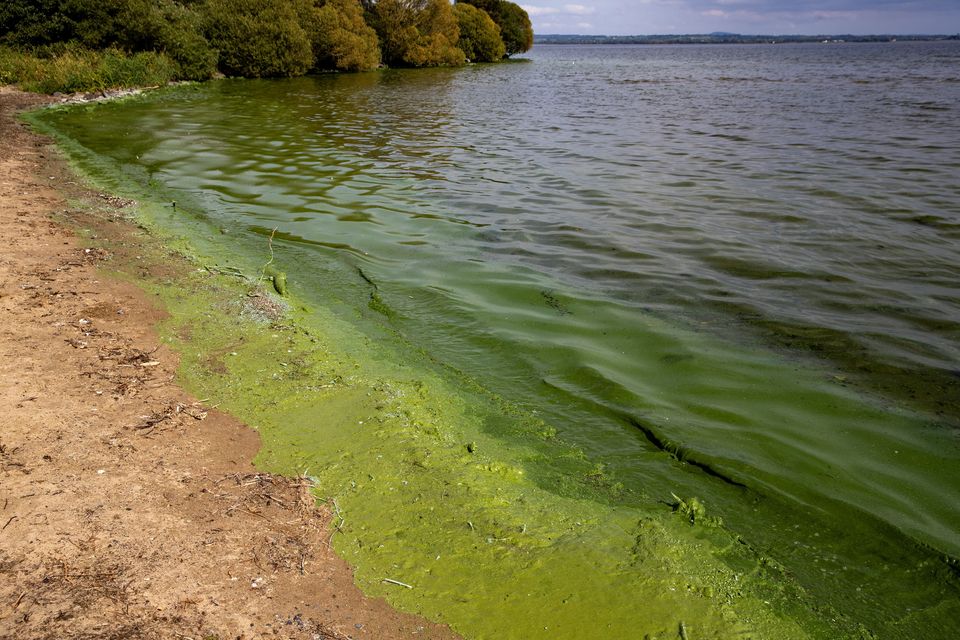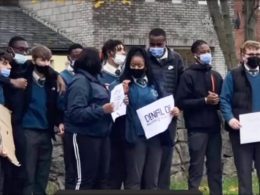By Peter McGregor
This summer has seen a massive bloom of blue-green algae in waters all across the north. This has included Lough Neagh and the River Bann, North Coast bathing waters and lakes in Fermanagh. If you live in an area that has been affected by the blooms and you haven’t seen it you’re bound to have smelled it– a gassy smell which fills the air for days on end.
Images have been shared online by people concerned about the quality of water beyond the waterways. Photos have shown what seems to be algal blooms in dog’s water bowls, babies’ bottle machines and hot tubs.
Why are the blooms a problem?
Blue-green algae, also called cyanobacteria, is harmful to public health, potentially causing rashes if came into contact with or illness if swallowed. Cyanobacteria is also incredibly harmful to livestock, wildlife and pets– an article in the Belfast Telegraph reported that a pet dog has died 35 miles from Lough Neagh after coming into contact with cyanobacteria on a beach.
The blooms have a wider impact on the health of our bodies of water and the wildlife within- it blocks sunlight from reaching other plants and uses up oxygen at nighttime and when decaying- this means it limits the amount of oxygen in the water causing harm to and killing fish, other creatures and plants in the water.
Where does Cyanobacteria come from?
Algae is naturally occurring and usually isn’t a cause for concern. Just like plants, algae requires sunlight, nutrients and carbon dioxide to grow. However, the real issues come about when there are excessive blooms- these large blooms are what stops sunlight from getting to other plants and the large amount of toxins to be released.
Huge algal blooms like this form when pollution from farm run-off and sewage meet sunlight and hot temperatures. This current crisis stems from the heatwaves we experienced in 2023, linked to climate change. The main nutrients which blue-green algae feeds on are nitrogen and phosphorus- two of the most common nutrients used in fertiliser. Our waterways are being polluted with these nutrients through fertiliser run-off, creating the conditions for these dangerous blooms of algae.
In 2021 a journalist estimated that 200,000 tonnes of sewage is discharged in the Lough Neagh area every year. Meanwhile pollution from farms was turbocharged by Stormont’s “Going for Growth” strategy. All Executive parties signed up to this plan to intensify agriculture in order to massively increase the profits of agribusiness companies. At the time, Michelle O’Neill said such a plan would “enhance our environment”. It has done quite the opposite. With a massive increase in pig and poultry farming throughout the 2010s, carbon emissions and pollution of waterways increased.
Who owns our waterways?
Lough Neagh, despite being used by the public on a daily basis, isn’t actually owned by the public. It is still owned by the far removed Earl of Shaftesbury, who has ruthlessly profiteered by extracting sand from the Lough for years, devastating local wildlife populations. The Lough is managed by the private company ‘Lough Neagh Partnership’. The River Bann and its outflows into the bathing waters on the North Coast are managed by government departments.
It’s clear, after 3 months of inaction on the blue-green algae crisis, that an aristocrat, a private company and government departments are not able to manage our waterways in a safe way. All natural resources, including all of our waterways, should be in the hands of working class people who rely on it for drinking water and our livelihoods. It has become obvious that ordinary people who live near, work on and use our waterways regularly know what is needed. On Ram’s Island for example, which is technically owned by Lord O’Neill, but is actually kept up to standard by a number of local volunteers. The Ram’s Island Heritage Project, which is a subsidiary of the independent River Bann and Lough Neagh Association, brings together local people who pool together their various skills- woodworking, building, painting, boat driving, etc. to ensure that the island remains at a high standard and is accessible to ordinary people on a regular basis.
Get organised to save our shores!
Local communities won’t take this any longer. People are starting to get organised, with over 4 thousand people joining a facebook group called ‘Save Our Shores! Protect Lough Neagh and our inland waterways’. A group called Love Our Lough organised a public meeting on 13 September and a wake for Lough Neagh on Sunday 17 September in Ballyronan.
Belfast City Council recently passed a Green Party motion calling for the public ownership of Lough Neagh; this is a positive step forward and should be replicated by other councils. It shows the real anger of ordinary people and the desire for our waterways to be nationalised. Unfortunately, this is largely symbolic and we need to go further to win nationalisation. A mass campaign which brings together all the affected communities can achieve decisive action and force through nationalisation.
Working-class communities in areas affected by the toxic blooms need to get organised, the wake and public meeting are a step towards this. Every town and village on the shores should now aim to have public meetings where people can raise their concerns, share knowledge of the issue, but also discuss how best we can organise to save our waterways.
But this fight needs to go beyond just the communities based on the shorelines as this issue is affecting all of the north. All working-class people have an interest in fighting this destruction as Lough Neagh provides 40% of the north’s drinking water.
When water and other natural resources are privatised, pollution and destruction are the inevitable outcome. This has been seen in the Thames Water crisis, where the service which was privatised in 1989 accumulated £14 billion of debts, suffered sewage spills and lacked massive investment in necessary infrastructure. Already Stormont, private companies and the Earl of Shaftesbury have led to our waterways being ravaged by the dangerous blooms. We can’t suffer even more by also having to pay for a service which we have a right to.
But we can guard against any further disasters by tapping into the potential that workers and communities getting organised has. For example water workers in the south of Ireland went on strike in mid-July to protect their job conditions, a main demand during that strike was for the government to set a date for a referendum to keep water as a public utility. We’ve also seen this massive potential during the recent strike wave which hit Britain and the north, where workers in many industries including manufacturing, public services, education, rail and health took determined action on pay and conditions.
There is an urgent need for trade unions to take up the destruction of our waterways through a public campaign as it impacts all working class people and because they hold potentially significant power if action is coordinated and linked with ongoing industrial struggles.
Immediate actions could put pressure on the Earl of Shaftesbury to hand back Lough Neagh. He has previously said he would consider selling the Lough to the NI executive, but this is just empty rhetoric because there is no executive to buy it!
Even the idea of using public money to buy the Lough is farcical. The Dorset based Earl has overseen its destruction this whole time! His sand extraction projects alone have contributed to a 75% decrease in the Lough’s duck population. Why should ordinary people financially reward the individual who has been a key part of this crisis? The Lough should be taken into public ownership without giving the Earl a penny.
The return of the Executive is not a magic solution either. While in the executive all the main parties’ played a horrendous role on climate and environmental issues. The executive has time and again failed local communities battling against the destruction of the environment- in 2022 the Department for the Economy renewed 2 licences for Dalradian Gold to continue its polluting mining, and there has been complete ignorance from the executive around calls for a ban on fracking in Fermanagh.
Whether or not there is a functioning executive one thing is clear- we need a mass campaign to win real action on climate and environmental issues. This means a linking up of local communities affected by blue-green algae, gold mining and fracking with workers and young people who are beginning to take action on the climate crisis.
Climate and environmental crisis
The fight to save our waterways is completely linked to the international climate and environmental crises. For years now governments and big corporations have known about the severity of the climate crisis and have refused to take action or, as with fossil fuel companies such as BP, have actively sought to cover it up. It is clear all over the world the effect the climate crisis is having, but at the same time carbon dioxide release levels are breaking records and gas and oil companies are making mammoth profits.
In December 2022 at the COP27 climate conference governments all around the world proved once again that they are completely incapable of solving the climate crisis. The conference didn’t actually have any concrete proposals to bring down carbon emissions or to take firm action on the crisis, and instead most of the discussions focused on watering down and weakening plans and agreements (which already weren’t enough) from previous conferences.
We need international action on the climate and environmental crises and all their local manifestations. The fight to save our waterways also needs to take up broader environmental demands to ensure our planet is saved from destruction.
We need:
- Public meetings in every town and village on the shores to discuss how best to organise
- A fully funded, democratically accountable independent inquiry into the blue-green algae crisis led by environmental organisations, trade unions and local community groups
- The immediate nationalisation and public running of Lough Neagh
- The setting up of an independent, fully funded and community ran body for the protection of our waterways
- Ban fracking, gold-mining and drilling for petroleum
- A socialist climate action plan which drastically reduces carbon dioxide emissions
- Nationalisation and public running of the energy sector, agri-business and big corporations to pivot away from non-renewables and provide reskilling to guarantee no job losses
- An end to the current system which puts the drive for profit above the needs of people and the planet












